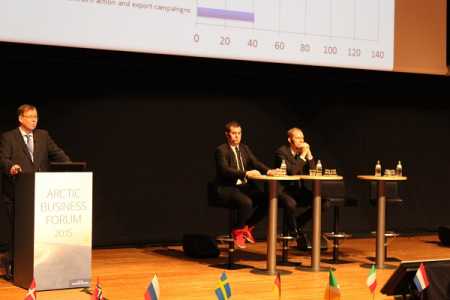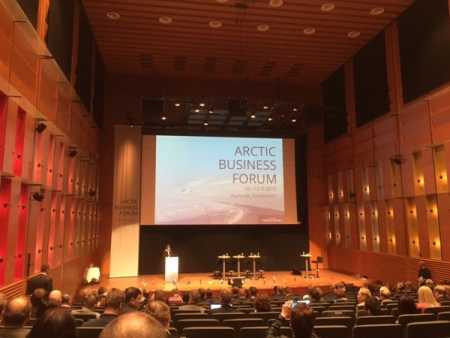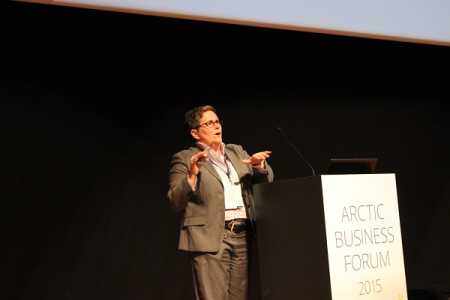|
Thu, 12 Mar, 2015 02:01:51 AM 6th Arctic Business Forum in Rovaniemi FTimes Report by Masud Riyad, March 12
The speakers including business leaders, diplomats, academicians and government officials emphasised attracting foreign investors to the arctic region and its various sectors like industry, shipping, mining, energy, transport and logistics. “The foreign investment is very much important to bring pace in arctic business amidst the financial crisis in the region,” said Lapland Chamber of Commerce President and Chief Executive Officer Timo Rautajoki at the forum organised by the chamber at Korundi House in Rovaniemi. He highlighted mining industry, oil and gas, hydro power, wind power, nuclear power, bio energy, energy transfer networks, tourism and transport infrastructure as public investments as potential investment sectors. The discussants mentioned China and South Korea as the possible big investors in the region. Earlier in the morning, the Lapland Chamber Board Chairman Juha Mäkimattila inaugurated the working session of the forum, where he emphasised concentrating on arctic oil, mining and forest sectors to boost up arctic business. He said increased use of digital media negatively affects the demand for newsprint and magazine papers, but, on the other hand, the use of digital printing opens up potential for new cost-efficient print processes and on-demand production. German Ambassador to Finland Dorothee Janetzke-Wenzel and Dutch Ambassador to Finland Henk Swarttouw also spoke at the inaugural session. The Germany ambassador underscored the need for scientific research and economic development to share responsibility in the region for the interest of economic and security policy.
Speaking on the occasion, Canadian Ambassador to Finland Andrée N. Cooligan said Finnish firms – shipping, maritime and arctic - have much to gain by establishing a first-to-market investment in Canada following the Canada-European Union Comprehensive Economic & Trade Agreement (CETA). She said CETA helps eliminate tariffs and reduce non-tariff barriers. Malte Humpert, executive director of Arctic Institute of Washington DC, observed that Northern sea route traffic will reach 40 million tonnes by 2020 and 70 million tonnes by 2030. Mikå Mered, managing partner, Polarisk group, United Kingdom, forecast a big arctic market in USA, Iceland, Finland, Faroe Islands, Denmark, France, Norway, Sweden, Canada and Russia by 2035. Sergey Katikov, adviser to the president of Russian Geographic Society, said the society has been carrying out expeditionary activities for more than 165 years. It organised hundreds of expeditions that have played great role in the opening of Arctic, Siberia and Far East, Middle and Central Asia, Australia and the World Ocean. The aim of Arctic Economic Council is to ‘share the best practices, explore the innovative solutions to promote responsible economic development in Arctic,’ said Rauno Posio, chairman of Lapland Hotels and Safaris and member of Arctic Economic Council. Antti Vehviläinen, director general of Finnish Transportation Agency, emphasized up-grading transport facilities in the arctic region, particularly in Finland, Sweden and Norway. Lapland Chamber publishes Yearbook 2015 On the occasion, the Lapland Chamber published the Yearbook 2015, which showed how the investment potential of the European High North in northern parts of Finland, Sweden and Norway and the regions of Murmansk and Arkhangelsk in Russia is still rising. The investment potential of these regions is already 197 billion euros, or 50 billion euros more than what was estimated last year. “The continuing financial crisis in Europe and the political tension caused by Ukraine have not impacted the development of the investment potential. “The crises have, however, clearly postponed the start of the projects and have made estimating the schedule more difficult,” said Lapland Chamber of Commerce CEO Timo Rautajoki. The Arctic Business Forum Yearbook also gives an estimate on the state of investments for the next five years. The estimate is presented based on two different scenarios. The “normal scenario” assumes the growth between 2016 and 2020 to be slow and the current unstable situation to continue specifically in offshore business.
According to the normal scenario, the value of investments to be started in the forthcoming five years would be slightly over 57 billion euros. The growth alternative would lead to investments worth more than 81 billion euros, including the launch of the huge Johan Castberg oilfield project in the Barents Sea. Further investment potential of either 140 billion euros or 106 billion euros could be realised in the future. North of Norway still clearly number one as it accounts for nearly 40 per cent or over 75 billion euros of the investment potential of the European High North. The largest projects are in the oil and gas industry, with a total value of over 40 billion. The second largest industry is wind power with its projects rising to over 16 billion euros in total value. The Oulu Region in Finland surprisingly reaches the second place with over 27 billion euros worth of investment projects. This region rises close to the top, thanks to its nuclear plant at Pyhäjoki by Fennovoima, with a value of 6.5-8 billion euros. The region also hosts a large number of wind power projects. The third largest investment potential is found in the Murmansk region with the potential of 23 billion euros. Norrbotten in Sweden ranks fourth with an investment potential of nearly 23 billion euros. The mining investments have been driving the growth of this region for over a decade and the boom seems to be continuing. Estimating the commencement time of investments is difficult. The prolonged economic crisis is hindering commencement of new investments. “The boom expected hasn’t started and a strong economic rise that would change the situation is not probable in the few coming years. However, the projects are up and running all the time and more are expected to start,” says Rautajoki. The huge offshore projects have been suffering from viability problems the last couple of years. Earlier, the viability of the arctic offshore projects went down not only by the economic crisis but also by the rapid increase in the production of shale oil and gas. The strong decline in oil price that started in the end of last year has sparked up the conversation about viability in the North. The Ukraine crisis and its sanctions has slowed down, and in many cases, also ceased the arctic offshore co-operation between the Russian and the Western companies. Publicly funded investments are seen to be driving development in the next few years, as it is typical during slow economic growth. The biggest investments are to be found in the traffic infrastructure, with investments estimated at nearly 12 billion euros. The largest projects are located in North of Sweden where the Norrbotniabanan-shoretrack from Umeå to Luleå and the second mine track from Kiruna to Narvik account for about half of the total investment value. Together with the investments in hospitals, the publicly funded investments rise up to 14 billion euros. More News
|
|
Finland Times
| Friday, 31 October, 2025 |




